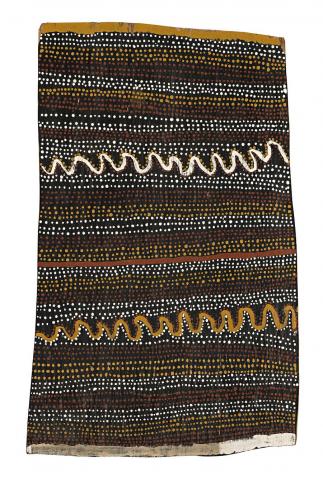UNTITLED, 1992
KUTUWULUMI PURAWARRUMPATU (KITTY KANTILLA)
natural earth pigments on eucalyptus bark
64.0 x 41.0 cm
Executed at Milikapiti, Melville Island
Jilamara Arts and Crafts, Melville Island
Private collection, Italy
Kitty Kantilla, National Gallery of Victoria, Melbourne, 27 April – 19 August 2007; Art Gallery of New South Wales, Sydney, 7 December 2007 – 21 January 2008, cat. 2
Barnes, K., Kiripapurajuwi – Skills of Our Hands: Good Craftsmen and Tiwi Art, Kathy Barnes, Darwin, 1999, p. 115 (illus.)
Ryan, J., Kitty Kantilla, National Gallery of Victoria, Melbourne, 2007, p. 16 (illus.)
Kitty Kantilla first began producing art in the 1970s after moving to the tiny, but important art community at Paru on Melville Island, just a short distance across the Apsley Strait from Nguiu on Bathurst Island and just far enough away from the Catholic mission that had been established early in the twentieth century to allow the community at Paru to live a more traditional life away from mission influence. It was here that Kitty began as a sculptor of ancestral figures such as those of Purukuparli and Bima, working with a group of widowed women who became renowned during the early 1980s for their iron wood sculptures of ancestor figures drawn from the Purukupali legend.
Kantilla's move to Milikapiti in 1989 coincided with the establishment of Jilamara Arts and Crafts and the appointment of James Bennett as manager. Bennett, keen to reconnect the contemporary generation of Tiwi artists with earlier painting traditions, suggested the artist produce paintings on bark. Coincidentally at this very time the National Gallery of Victoria also approached Jilamara to commission Kantilla and other Tiwi artists to produce paintings on bark. The National Gallery of Victoria works were produced between April and July in 1992 and represent a moment in time in the production of Tiwi art and its evolution in style and practice from earlier times. Our painting, Untitled, 1992, is one of very few works on bark executed by the artist later in 1992.
Kantilla rarely explained the symbols and designs in her paintings, preferring to say simply that she paints like her father and her grandfather. As with other paintings by Kantilla, the designs in this picture bear similarities to those painted on the sides of the earliest Tiwi bark baskets that are made for utilitarian purposes and for the Pukumani burial ceremonies. However, an interesting footnote in the glossary of works from Judith Ryan's exhibition catalogue from 1997 notes that 'the meanders in this work make reference to the patterns that the artist observed on the monitor of a hospital ECG machine'.1
1. Ryan, J., Kitty Kantilla, National Gallery of Victoria, Melbourne, 1997, p. 100
CRISPIN GUTTERIDGE
